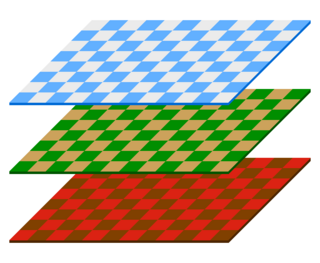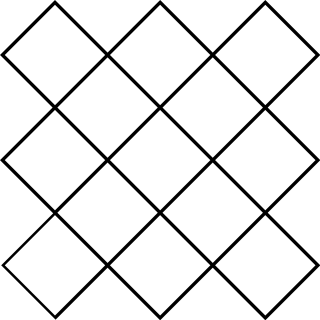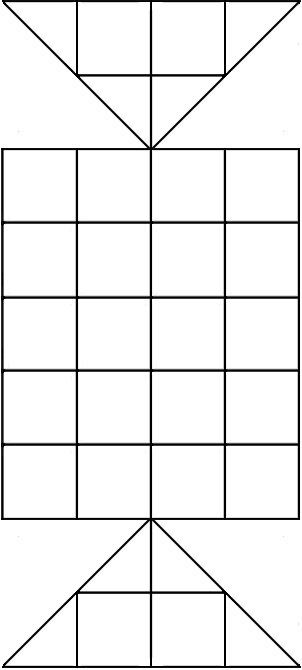Three men's morris is an abstract strategy game played on a three by three board that is similar to tic-tac-toe. It is also related to six men's morris and nine men's morris. A player wins by forming a mill, that is, three of their own pieces in a row.
Fox games are a category of asymmetric board games for two players, where one player is the fox and tries to eat the geese / sheep, and the opposing player directs the geese/sheep and attempts to trap the fox, or reach a destination on the board. In another variant, Fox and Hounds, the fox merely tries to evade the hounds. There are several versions known:

Ludus latrunculorum, latrunculi, or simply latrones was a two-player strategy board game played throughout the Roman Empire. It is said to resemble chess or draughts, but is generally accepted to be a game of military tactics. Because of the scarcity of sources, reconstruction of the game's rules and basic structure is difficult, and therefore there are multiple interpretations of the available evidence.

Dragonchess is a three-dimensional fantasy chess variant created by Gary Gygax, co-creator of the famed role-playing game Dungeons & Dragons. The game was introduced in 1985 in issue No. 100 of Dragon Magazine.

Hexagonal chess is a group of chess variants played on boards composed of hexagon cells. The best known is Gliński's variant, played on a symmetric 91-cell hexagonal board.
Permainan-Tabal is a two-player abstract strategy board game from Indonesia. The game is sometimes referred to as a cross between Alquerque and Draughts. It is essentially Draughts played on an expanded Alquerque board. It is especially similar to Draughts in that the moves of the pieces are strictly forward and sideways until they are promoted to Kings by reaching the other player's first rank. The game is also referred to as Dama.

Kōnane is a two-player strategy board game from Hawaii. It was invented by the ancient Hawaiian Polynesians. The game is played on a rectangular board. It begins with black and white counters filling the board in an alternating pattern. Players then hop over one another's pieces, capturing them similar to checkers. The first player unable to capture is the loser; their opponent is the winner.
Rimau-rimau is a two-player abstract strategy board game that belongs to the hunt game family. This family includes games like Bagh-Chal, Main Tapal Empat, Aadu puli attam, Catch the Hare, Sua Ghin Gnua, the Fox games, Buga-shadara, and many more. Rimau-rimau is the plural of rimau which is an abbreviation of the word harimau, meaning 'tiger' in the Malay language. Therefore, rimau-rimau means 'tigers'. The several hunters attempting to surround and immobilize the tigers are called orang-orang, which is the plural of orang, meaning 'man'. Therefore, orang-orang means 'men' and there are twenty-two or twenty-four of them, depending on which version of the game is played. The game originates from Malaysia.
Main tapal empat is a two-player abstract strategy board game from Malaysia. It is a hunt game, and specifically a tiger hunt game since it uses an Alquerque board. The tigers can move as many spaces in a straight line as a clear path allows. Most hunt games have tigers, leopards, or foxes moving only one space at a time. In effect, the tigers in this game have the movement capability of the queen in chess.

Bear games is a category of board games of which many have historical roots in the Roman Empire. They were played in parts of the Empire as far away as Turkey and France and are still played today, especially in Italy. All of the games are two-player abstract strategy board games. Normally, the game is played with three hunters and one bear on a patterned board. It bears similarity to the hunt games such as the Fox games, Rimau-rimau, and Bagha-Chall, however, there are no captures involved. The three hunters are trying to hem in the bear, and block its movements.
Rimau is a two-player abstract strategy board game from Malaysia. It is a hunt game, and specifically a tiger hunt game since it uses an expanded Alquerque board. One tiger is being hunted by 24 men. The tiger attempts to eat the men, and the men attempt to trap the tiger. Unique to Rimau, the tiger can capture a line of men in a single leap. There must be an odd number of men in the line, and they must be adjacent to one another. In most hunt games, the tiger, leopard, or fox is only able to capture one prey in a leap.

Buga-shadara, also known as Bouge Shodre, is a two-player abstract strategy board game from Tuva, a republic in Siberia, Russia. It is a hunt game where one player plays the deer. There are two deer usually represented as the black pieces. The boars are also referred black in the referenced article "Buga-shadara a folk game from Tuva". The other player has 24 white pieces with dogs associated to them. The board consist of an Alquerque board flanked on two of its opposite sides by a square patterned board. Because the board is in part an Alquerque board, this makes Buga-shadara a tiger hunt game. What makes Buga-shadara unique among tiger games are the expansion boards on the two opposite sides of the Alquerque board. They are square, whereas most are triangle-like. The word "shadara" resembles the word "shahdara". The "shah" part "is a title given to the emperors/kings and lords of Iran .". There is a place called Shahdara Bagh in Lahore, Punjab, Pakistan, and it's thought that the word "Shahdara can be translated as "the way of kings". Shah translates as "king" and dara translates as the way of kings." The referenced article associates the boars as kings. Perhaps the boars or deer are kings, and have to find a way or have a way with the white pieces or dogs.
Sher-bakar is a two-player abstract strategy board game from Punjab, India. It is a hunt game. It uses an Alquerque board, and therefore, Sher-bakar is specifically a tiger hunt game. There are two tigers attempting to elude and capture as many of the other player's pieces which in other hunt games in this part of the world is often referred to as a goat, cows, lamb, or men. An interesting and uncommon feature in this game is that the goats, cows, lamb, or men are piled up on four points of the board at the beginning of the game. Piling up pieces is an unusual feature in hunt games or any board game in general. The only other hunt game that uses this feature is Bagh bandi, a game closely related to Sher-bakar. Hereinforth, the white pieces will be referred to as goats.
Bagh bandi is a two-player abstract strategy board game from Lower Bengal, India. It is a hunt game. It uses an Alquerque board, and therefore, Bagh bandi is specifically a tiger hunt game. There are two tigers attempting to elude and capture as many goats while the goats are attempting to surround and trap the tigers.

Liberian Queah is a two-player abstract strategy game from Liberia. It is specifically from the Queah tribe. The game is played on a slanted or diagonal square board with only 13 spaces. Pieces move "orthogonally" along these slanted or diagonal square boards. Another unique feature is that each player must have four pieces on the board. Each player's captured piece is resupplied at the beginning of their next turn with a piece from their reserve.
Catch the Hare is a two-player abstract strategy board game from Europe, and perhaps specifically from Spain. It is a hunt game, and since it uses a standard Alquerque board from the game Alquerque de Doze, it is specifically a tiger hunt game. In some variants, some or all of the diagonal lines are missing which makes it difficult to classify as a tiger game in general. One hare is going up against ten to twelve opponents(hunters or hounds). The hare is the "tiger" in this hunt game which is prey and predator at the same time. The hare can capture the opponents by leaping over them. The opponents attempt to surround and trap the hare.
Indian and jackrabbits is a two-player abstract strategy board game from the Tiwa tribe of Taos, New Mexico. A similar game with a slightly different board is also played by the Tohono O'odham tribe of Arizona. From the outset, these games look like hunt games similar to Catch the Hare, the Fox games of Europe, and the tiger and leopard games of Asia, because they use very similar boards, and the game mechanics are the same, and the number of pieces each player controls is different. However, they are not the same games, because the goals are completely different. The goal of the one Indian is to capture just one of the twelve jackrabbits. The goal of the jackrabbits is to move themselves safely onto the other side of the board mirroring their initial positions.
Tiger and buffaloes is a two-player abstract strategy board game from Myanmar. It belongs to the hunt game family. The board is a 4x4 square grid, where pieces are placed on the intersection points and move along the lines. It is one of the smallest hunt games. Three tigers are going up against eleven buffaloes. The tigers attempt to capture as many of the buffaloes by the short leap as in draughts or Alquerque. The buffaloes attempt to hem in the tigers.
Sua Ghin Gnua is a two-player abstract strategy board game from Thailand, formerly known as Siam. Another name for the game is Tigers and Oxen. It is a hunt game played on a 5x5 square grid with only orthogonal lines. One player plays the three tigers, and the other player plays the twelve oxen. The board is empty in the beginning. Players first drop their pieces onto the board, and then are able to move them. The tigers can capture the oxen by the short leap as in draughts and Alquerque, but the oxen attempt to elude and at the same time hem in the tiger. Sua Ghin Gnua most resembles the tiger hunt games such as Bagh-Chal, Rimau-rimau, Main Tapal Empat, Catch the Hare, and Adugo since they all use a 5 x 5 square grid. But tiger games technically consist of a standard Alquerque board which is a 5 x 5 square grid with several diagonal lines criss-crossing through it which are completely missing in Sua Ghin Gnua. There are however some variants of Catch the Hare which have missing diagonal lines also. Another game that resembles Sua Ghin Gnua is from Myanmar called Tiger and Buffaloes which is a hunt game consisting of a 4 x 4 square grid with no diagonal lines. Myanmar happens to border Thailand geographically so there might be a historical connection between the two games. Another game from Myanmar is Lay Gwet Kyah that is presumed to be similar to Sua Ghin Gnua. Sua Ghin Gnua was briefly described by Stewart Culin, in his book Chess and Playing Cards: Catalogue of Games and Implements for Divination Exhibited by the United States National Museum in Connection with the Department of Archaeology and Paleontology of the University of Pennsylvania at the Cotton States and International Exposition, Atlanta, Georgia 1895 (1898). It's also briefly mentioned by H.J.R. Murray in his book A History of Chess (1913). It was also described by R.C. Bell, in his book Board and Table Games from Many Civilizations (1969).

Astar is a two-player abstract strategy board game from Kyrgyzstan. It is a game similar to draughts and Alquerque as players hop over one another's pieces when capturing. However, unlike draughts and Alquerqe, Astar is played on 5x6 square grid with two triangular boards attached on two opposite sides of the grid. The board somewhat resembles those of Kotu Ellima, Sixteen Soldiers, and Peralikatuma, all of which are games related to Astar. However, these three games use an expanded Alquerque board with a 5x5 square grid with diagonal lines. Astar uses a 5x6 grid with no diagonal lines.








